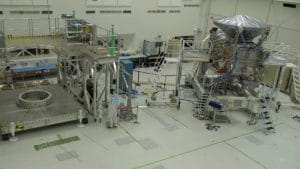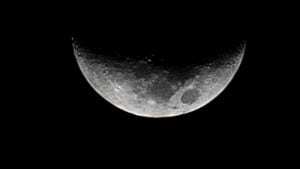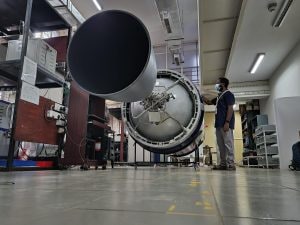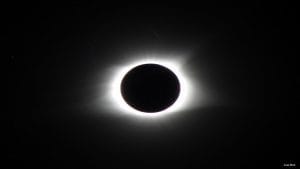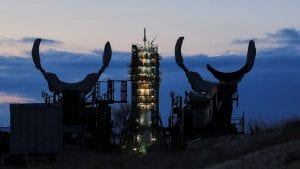What to look for in the images of the solar eclipse today

KV Prasad Jun 13, 2022, 06:35 AM IST (Published)
 Listen to the Article (6 Minutes)
Listen to the Article (6 Minutes)
Summary
The corona, the birthplace of the solar wind, is a million times dimmer than the Sun’s disk, which makes it difficult to see with an aid. The researchers have to rely on telescopes equipped with camera and an occulting disk that blocks the Sun’s ultra-bright face. And, the scientists will take a few months to study the data from the images collected to come to a conclusion, writes science columnist Vanita Srivastava.
As the Sun is bracing itself to temporarily disappear from the sky over North America today (April 8, 2024), volunteers and citizen scientists will endeavour to capture the photos of the solar eclipse fundamentally to make a deeper understanding between the Sun and the Earth.
Astronomers, physicists, eclipse chasers, skywatchers, citizen scientists are all geared up to savour and study an event that lasts for a few minutes but which can be condensed for a lifetime.
A solar eclipse happens when the Moon passes between the Sun and Earth, completely blocking the face of the Sun. People located in the centre of the Moon’s shadow when it hits Earth will experience a total eclipse. The solar eclipse will move through a 115-mile-path of totality across Mexico, the United States and Canada. In a total solar eclipse, one of the most fascinating phenomenon, the corona of the Sun will be visible for upto 4 minutes and 28 seconds, depending on your location.
What to Look For
While some are amateurs simply trying to understand the unfolding of the celestial mystery, a large number of volunteers will be participating in NASA funded science projects to study the corona, which is the outer atmosphere of the Sun.
The images and the footages could help scientists learn more about the solar corona, the sun’s outermost atmosphere like the strength of its solar winds, and how magnetic energy there is converted into heat. This kind of imaging of the corona is made possible only by the eclipse, when only the bright ring of the sun’s corona will be left visible.
The corona is the birthplace of the solar wind – a constant stream of particles and material flowing from the Sun that impacts Earth and other planets. The best time to see the full range of dynamics in the corona is during a total solar eclipse. The corona has always been one of astronomy’s biggest unsolved mystery.
The corona is a million times dimmer than the sun’s disk, which makes it difficult to see with an aid. The researchers have to rely on telescopes equipped with camera and an occulting disk, that blocks the sun’s ultra-bright face.
The scientists will take a few months to study the data from the images collected to come to a conclusion.
Flying Fleet
A group of volunteers will be flying on an airplane to study the eclipse.
Chad Madsen, an astrophysicist from the Center for Astrophysics, Harvard & Smithsonian., one of the scientists working on the Airborne Coronal Emission Surveyor (ACES) mission told CNBCTV18 that during the eclipse totality, the volunteers will be observing the solar corona in the infrared from the National Science Foundation/National Center for Atmospheric Research’s Gulfstream V research aeroplane.
“The airplane will fly at 14,300 meters altitude (much higher than the normal altitude of commercial aeroplanes) to avoid much of the water vapour in the atmosphere and will follow the eclipse path over the US state of Texas. ACES is a spectrometer that will search for emission lines in a little-observed infrared wavelength range. We want to see if these emission lines could be used as physical diagnostics of the corona; particularly, we want to use these lines to measure temperatures, densities, and magnetic field strength, “Madsen said.
Treasure Trove
The volunteers of the three NASA projects will be placed all across the eclipse path, extending through more than 90 minutes, essentially the time taken for the Moon’s shadow to cross from Mexico to Canada. The images that will be captured will be condensed into videos and movies for showing the activities in the corona.
NASA had made similar movies in 2017 by collating the images collected but this time an attempt will be made to make it more dynamic.
“We are studying the dynamics of the inners solar corona. We have more than 80 observation teams. I’m not sure of the exact count on volunteers. I believe it’s over 300,” Bob Baer who leads the Dynamic Eclipse Broadcast(DEB) told CNBCTV18.
Matt Penn of Southern Illinois University in Carbondale who also leads the DEB initiative told CNBCTV18 that the scientific goal of the project was measuring acceleration of coronal plasma in the inner corona.
“In 2017 our group made the first such measurement during a total eclipse; we published our results where we showed how solar plasma accelerated from rest to a speed of about 200 km/s in the inner corona. Our goal for 2024 is to make a similar measurement, or perhaps several, in different parts of the inner corona.”
Additionally, the volunteers will provide a near-real time broadcast of the eclipse, uploading an image from their telescopes at a cadence of once per minute to our webpage. Our team of over 300 volunteers is looking forward to sharing our eclipse experience with people around the globe.”
Led by Amir Caspi of the Southwest Research Institute in Colorado, the Citizen Continental-America Telescopic Eclipse(CATE) 2024 project of NASA will place 35 teams in the eclipse path from Texas to Maine to capture the corona in polarised light.
‘The Citizen CATE 2024 project will study the solar corona, and specifically is looking to get information to help us answer two big questions about the Sun,” Caspi said in an interview with CNBCTV18.
Why the Sun’s Corona So Hot
Fundamentally, he said our team will try and understand why the Sun’s corona (its outermost atmosphere) is so hot. “The corona is millions of degrees Celsius, but the solar surface underneath is only about 6000 degrees Celsius. So what is the reason why the corona is getting so much hotter.”
Caspi said his team will also try and study how is the solar wind ‘born’. The solar wind is a constant stream of energetic particles that come off the Sun into an interplanetary space, but we are still not aware about how the wind is accelerated to the speeds we see and where the structure(turbulence) in the solar wind comes from.
CATE 2024 will use special cameras that can measure not just visible light but the polarisation of that light, kind of like having polarised sunglasses on every pixel of the camera.
“Measuring the polarisation gives us information about the structure of the corona and how much material is there and we will have high-contrast images every 2 seconds of totality for upto an hour of totality as the eclipse shadow crosses the United States. This will allow us to study the structures in the corona and how they evolve in various lengths of time ranging from tens of seconds up to tens of minutes.”
There are 35 teams of community volunteers in the project who will be deployed all along the eclipse path from the Eagle Pass in Texas to Houlton in Maine to observe the corona during totality at each respective site. Each team will use a uniform set of equipment provided by the project including the cameras along with telescopes, mounts, computers and other hardware.
“We have nearly 200 participants across the whole project. Teams will take data on the computers we have supplied and will then upload them to our servers and also send a disk by mail as a backup.”
The Objectives
The long term objective is both for science—to understand the Sun’s corona—and for outreach and education—to provide a unique and valuable experience for the non-scientists, particularly those from communities that have been underrepresented in astronomy and science in general.
“We hope that this is a transformative experience that can help to promote a lifelong love of science, potentially sparking new careers in science. And the equipment we have provided will remain in the communities to serve as a long term educational resource.”
Led by Laura Peticolas of Sonoma State University in California, the Eclipse Megamovie project has asked the participants to capture the corona using their own DSR cameras on mounts that will track the Sun’s position in the sky during the eclipse.
The project has sent tracking mounts to more than 70 individuals who will be stationed along the eclipse path in the US and Mexico.
Eclipse Megamovie 2024(EM2024) is funded by NASA to discover the secret lives of solar jets and plumes. Many jets and plumes seem to disappear or change from the time they are formed on the Sun and when they move out into the solar win. The photographs taken by the volunteers will identify the solar jets as they leave the Sun’s surface and solar plumes as they grow and develop.
Predicting Pattern
Predictive Science, a research and product-development firm in San Diego, California had last month released a preview of how the Sun many appear on April 8. The team including astrophysicist Cooper Downs, used real-time satellite data of the Sun’s surface magnetic fields and intensive supercomputer simulations to make the prediction.
The firm’s prediction shows a corona composed of several spiky, spade-like structures called streamers, in which coronal plasma is tightly confined by magnetic field lines that leave the Sun’s surface but loop back into it. Streamers glow brighter than other parts of the corona because electrons in the denser plasma scatter sunlight.
“The Sun is near the maximum phase of the solar cycle, so the solar magnetic field is evolving rapidly. To better capture the dynamic nature of the Sun at this time, we are using time dependent MHD model that is updated in near real-time with the latest measurements of the surface magnetic field,” says its website.
Chasing the Eclipse
Shadia Habbal, a solar eclipse researcher at the University of Hawaii, is hoping to record and analyse the coronal mass ejections, which occur when the sun’s churning magnetic field blasts strands and blobs of material out into space. These coronal mass ejections disturb the flow of the solar wind and can cause damage to satellites and disrupt communications, making it very important to be able to understand and predict their activity.
“Our hope is from the data we are collecting, we will try to get a better understanding of the physical processes that are going on and try to figure out if we can predict when a coronal mass ejection is going to interfere with the Earth’s magnetic environment,” she said
Our hope is from the data we’re collecting, we’ll try to get a better understanding of the physical processes that are going on, and to try to figure out if we can predict when a coronal mass ejection is going to interfere with the Earth’s magnetic environment,” she said while conversing with the Hawai’i Public Radio.

Elon Musk forms several ‘X Holdings’ companies to fund potential Twitter buyout
3 Mins Read
Thursday’s filing dispelled some doubts, though Musk still has work to do. He and his advisers will spend the coming days vetting potential investors for the equity portion of his offer, according to people familiar with the matter

KV Prasad Journo follow politics, process in Parliament and US Congress. Former Congressional APSA-Fulbright Fellow










 Listen to the Article
Listen to the Article  Daily Newsletter
Daily Newsletter





